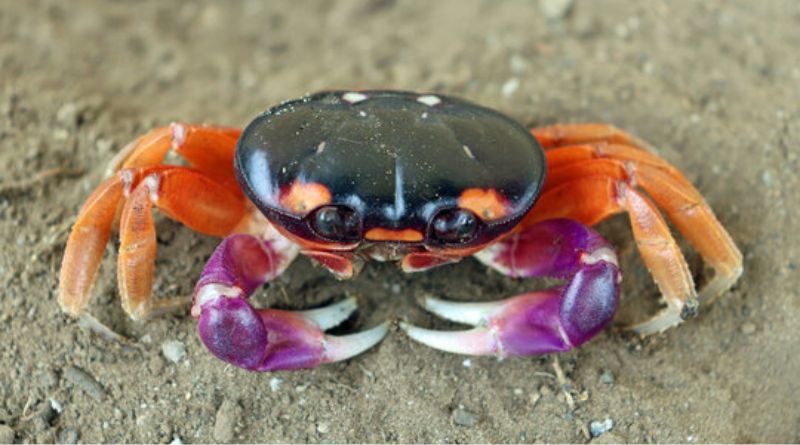The Halloween crab (Gecarcinus quadratus), also known as the Halloween land crab, is a strikingly beautiful species of land crab found in parts of Central and South America, particularly along the Pacific coast of Costa Rica, Nicaragua, and Panama. Named for its bright orange and black color pattern, reminiscent of Halloween decorations, this crab is not only an interesting part of the local ecosystem but also a favorite for wildlife enthusiasts and photographers. In this article, we’ll dive into the biology, behavior, and habitat of the Halloween crab, as well as answer some frequently asked questions about these unique creatures.
Table of Contents
Physical Characteristics
The Halloween crab gets its name from its distinctive appearance. These crabs have a vibrant orange to red body with black markings, particularly on their claws and legs, creating a contrast that resembles the colors of Halloween—orange and black. Here’s a closer look at their features:
- Size: Halloween crabs are relatively small, with adults typically measuring between 3 and 4 inches across their carapace (the hard shell covering their body). They have long, spindly legs and large claws that are often asymmetrical—one claw is larger than the other.
- Coloration: Their striking coloration makes them stand out in their natural habitats. The black and orange hues not only serve as camouflage against certain backgrounds but also play a role in warning predators. This vibrant color is a form of aposematic coloration, signaling that the crabs may not be palatable or easy to handle due to their hard shells and sometimes aggressive nature.
- Claws and Limbs: The Halloween crab’s claws are strong and help them forage for food, defend themselves, and dig burrows. Their smaller claw is used for feeding, while the larger claw, though often less dexterous, is used for defense.
Habitat and Distribution
Halloween crabs are primarily found in mangrove forests, coastal woodlands, and rainforests. They live in the tropical and subtropical zones of the Pacific coasts of Central and South America, with a range that extends from southern Mexico down to western Panama.
These crabs spend the majority of their time on land, but they do need access to water, which they find in nearby streams, puddles, or the high tides of coastal regions. Unlike many crabs that live in the ocean, Halloween crabs are terrestrial and are most often seen near the beach or in the forest. They dig burrows in the ground where they live, seek shelter, and store food.
The Role of the Mangrove Ecosystem
Mangrove forests are essential to the Halloween crab’s life cycle. These forests provide food and shelter, as well as a place for the crabs to burrow and reproduce. The crabs often forage for food among the mangrove roots and surrounding plant life.
Behavior and Diet
Halloween crabs are omnivorous scavengers, meaning they feed on both plant and animal matter. Their diet consists of:
- Leaves and other plant material
- Dead animals, such as fish, small invertebrates, or decaying organic matter
- Fruit and seeds found in their habitats
They are primarily nocturnal, emerging from their burrows at night to feed. During the day, they seek shelter in the safety of their burrows or hide under rocks and vegetation to avoid predators.
Social Structure and Mating
While Halloween crabs are solitary animals for the most part, they may be found in small groups when food is plentiful or during mating seasons. Their mating behavior is particularly fascinating:
- Mating Season: Typically, Halloween crabs mate during the wet season, which ensures that the females have access to ample moisture for egg-laying. Males will often fight for the attention of females, using their large claws to establish dominance.
- Egg-Laying: Female Halloween crabs will lay their eggs in the safety of their burrows. After hatching, the larvae are typically released into the water, where they undergo several stages of development before they eventually return to land as juvenile crabs.
Threats and Conservation
The Halloween crab is not currently listed as endangered, but it does face several threats:
- Habitat Loss: Mangrove deforestation and coastal development are major threats to the Halloween crab’s natural habitat. As human activity expands along coastlines, crabs lose their burrowing areas and food sources.
- Climate Change: Rising sea levels and changing weather patterns also threaten their coastal environments. Increased temperatures and extreme weather events can disrupt their delicate ecosystems.
- Predation: While the bright coloration of the Halloween crab acts as a deterrent for some predators, they are still preyed upon by birds, larger crabs, and even some mammals.
Conservation efforts to protect mangrove forests and coastal habitats are crucial for the survival of the Halloween crab and other species that rely on these ecosystems.
Fun Facts About Halloween Crabs
- They are nocturnal: Halloween crabs are mostly active at night, emerging from their burrows to feed under the cover of darkness.
- Bright colors as a warning: Their bold color scheme serves as a warning to predators that they may not be easy to catch or eat.
- Mimicry with Halloween imagery: Their bright orange and black coloring has earned them the Halloween moniker, and they are often seen as a living embodiment of Halloween-themed creatures.
- They can live in burrows for months: Halloween crabs are capable of surviving without access to water for extended periods of time, as long as they remain in their burrows and conserve moisture.
FAQs About Halloween Crabs
1. Are Halloween crabs good pets?
Halloween crabs can make interesting pets, but they require specific care. They need a habitat with both dry and humid conditions, access to fresh water, and a diet of fruits, vegetables, and occasional protein. They can also be territorial and may not do well when kept with other crabs or animals. It’s essential to mimic their natural environment to ensure they thrive.
2. How long do Halloween crabs live?
In the wild, Halloween crabs typically live for around 3 to 4 years, although they may live longer in captivity with the proper care and diet.
3. Are Halloween crabs dangerous to humans?
Halloween crabs are not dangerous to humans. While they have large claws and can become aggressive when threatened, they are not venomous and generally pose no serious threat. Their bright coloring acts as a warning to predators, but humans are not at risk from direct interaction.
4. Can Halloween crabs swim?
Although Halloween crabs live near water and may spend some time in coastal areas, they are not strong swimmers. They are primarily terrestrial creatures and prefer to stay on land, where they dig burrows and find food.
5. How do Halloween crabs help the environment?
Halloween crabs play an important role in their ecosystem by acting as scavengers. They help break down organic material, such as dead plants and animals, which contributes to nutrient recycling in their habitats. Their burrowing also helps aerate the soil, which can improve the overall health of the environment.
Conclusion
The Halloween crab is a fascinating and colorful creature that plays an important role in the ecosystems of Central and South America. Its unique appearance, nocturnal habits, and interesting behaviors make it a subject of intrigue for wildlife enthusiasts. However, like many species in tropical environments, Halloween crabs face threats from habitat destruction and climate change. Protecting their coastal and mangrove habitats is essential for ensuring these vibrant crabs continue to thrive in the wild for years to come.






